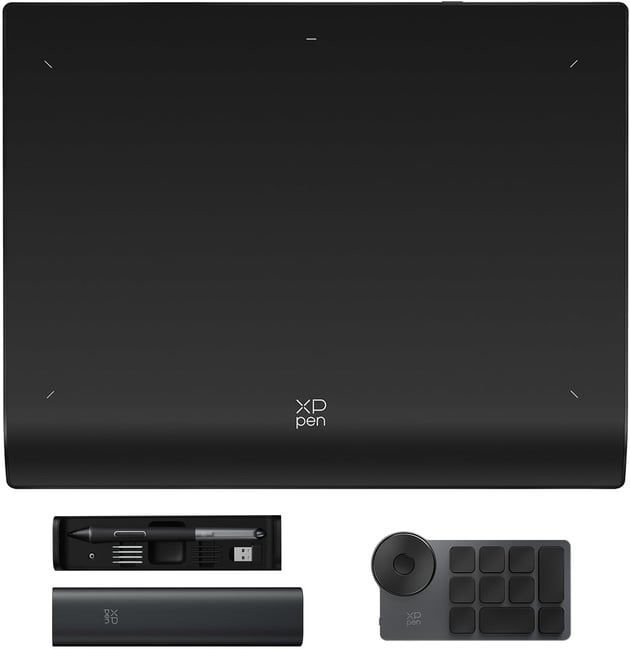Pen tablets, which serve as an alternate to your computer’s mouse or trackpad, have become increasingly popular for photo editing. In this guide, I’ll take a look at the benefits of a tablet, including which Photoshop tools benefit the most from the added control. Lastly, I’ll go over my experience with some of my favorite pen tablet models.
Table of Contents
Tablet Benefits
1. Accurate Selections
While today’s version of Photoshop has provided a lot of powerful, automated selection tools, I still run into photos where I just have to make a manual selection. With a mouse, it is very difficult to make fine, organic selections manually. It’s much easier with a pen tablet – just like writing with a pen. This not only helps with selections but also with manual brush adjustments if you’re doing something like dodging or burning.
2. Pressure Control
Any good pen tablet will offer control via pressure sensitivity. Unlike a mouse, which can only switch between on or off by pressing the mouse button, a pen tablet can transmit information about how hard you’re pressing. Some tablets can even register the angle that you’re holding the pen.
When used with compatible tools, like with Photoshop’s brushes, this lets you apply lighter or heavier strokes with just different pressure. It helps make the strokes look more natural than they ever could with a mouse.

3. Ergonomic Benefits
I find that there’s an ergonomic benefit from using a tablet rather than a mouse. While this isn’t medical advice, and may not be applicable to everyone, I’ve felt more comfortable holding a pen that can be grasped in different ways and angles. For photographers who have carpal tunnel or arthritis, it can help simply to have the option to switch between a pen and a mouse as needed.
4. Workflow Flexibility
Some models of tablet will offer a range of additional buttons or controls that can help with your photography workflow. These may include scroll wheels or macro keys, for example. While the right mouse may also offer additional buttons, very few mice will have support for the 7+ macro keys available on many tablets.
5. Time Savings
Since it’s easier to make selections and natural-looking brush strokes with a pen tablet, this also saves you time in the long run. If you’re the type of photographer who often does local edits, you’ll probably find that you need to “undo” your brush strokes less often, and that you spend less time changing the opacity/flow settings as well.
Using a Pen Tablet with Photoshop
Pen tablets function just like a mouse, so you can use them in any app. That said, there are a few situations where you’ll really get the most benefit.
Photoshop is my primary use case – the pressure sensitivity lets you adjust brushes, paint accurate masks, and dodge or burn with ease. Other Photoshop-style editors should also offer a similar level of support. The same is true if you’re doing local adjustments in Lightroom, although global adjustments and sliders in general are no faster with the tablet.

In Photoshop, any brush or brush-like tool will benefit. With the tool active, I recommend viewing the toolbar to see what settings are related to pressure. The regular brush can toggle pressure control over opacity, flow, or size.
More than anything else in Photoshop, I love using my pen tablet for layer masking. Most photographers are aware how powerful layer masks can be, but also how a poorly-drawn mask can lead to haloing and other issues in your photo. With gentle pen strokes, you can paint lightly on your layer mask and get very fine control over how they look.

Recommended Pen Tablets
On the entry-level side of things, there are many different affordable, compact pen tablets available. While these won’t be the best experience, since mapping a large screen area to a compact drawing area compromises on accuracy, they still can work well for basic pressure control. Using them will require some switching between mouse and tablet, however – they are really best used when mapped to a smaller portion of a larger screen, in my opinion.
You can start with pen tablets for as low as $70 with a tablet like the small Wacom Intuos Creative, but the smallest size I’d really want to use would be the medium size, which bumps the drawing area up to 8.5 x 5.3 inches (and the price up to $200, although it’s often on sale for $100).

Moving up the budget provides a few benefits. However, at higher prices I’d recommend looking beyond the “Wacom realm.” While Wacom definitely carries the most name recognition, there are lesser-known brands offering better values and similar quality. I say this as someone who has a Wacom Intuos Pro and really likes it, but have tested less expensive models that perform better.
From XPPen, the Deco Pro 11-inch model feels like the sweet spot of size, features, and price point. It includes 16,000 levels of pressure sensitivity and 60 degree tilt sensitivity, along with integrated wireless capability and a 10-key shortcut remote. At $170, this is a great value for a tablet with excellent performance.

Moving up to a model with an integrated screen, rather than just a drawing surface, can make a big difference in usability – particularly for those new to a tablet interface. While screenless pen tablets are still pretty easy to learn, some people find a disconnect between looking at the screen and drawing on a surface.
For photographers looking for a screen model, XPPen’s Artist Pro line and the Wacom One Creative Pen Display are both viable options. Both have 1920×1080 resolution panels, which makes things easy when mirroring your display, as it preserves the aspect ratio. The XPPen model has a larger color gamut and a larger screen, but costs more – I’ve tried them both and think the better choice depends on your budget.

Further upgrades are always out there – no surprise. These pen tablets will add even better looking screens, with sizes of 20 inches or more. However, for photographers who aren’t dedicated retouchers or digital artists, I think these models would be overkill. Screens around the 14 to 16 inch size don’t take up too much space on your desk when not in use, while still offering plenty of workable space for most photography-related tasks.
Overall, I think tablets and tablet displays are a great addition to a photographer’s workflow, particularly for heavy Photoshop users or any photographer who does frequent local edits. Have you tried post-processing with a pen tablet? Let me know your experiences in the comments below!
My journey with Wacom began with the CS 5.5 release. The precision offered correcting croma key photographs made selecting hair less like…well, pulling hair and in many cases the only possible means of perfecting the selections.
These days I find the M1 iPad Pro 12.9 with an Apple Pencil to be my tool of choice. As I no longer own a desktop, the iPad covers all my needs unless I fail to get it in the camera and have to resort to extensive editing on a laptop.
I can not emphasize enough how the tablet path solves many of the problems involved in making selections.
Using a pen is so much more refined than moving a mouse; Then it is also pressure and angle-to-tablet sensitive.
I started using it 20 years ago when i had to do some repeated photo-work and was developing RSI-problems in my arm. The pen has saved me from that.
The extra buttons on the tablet are programmed to do the basic actions fast. Yes for me it is an absolutely necessary equipment to work fast and fluent.
@ tony: an iPad is nice for sketching, but there are so many limitation in iOS i really feel free again when working on a computer. Also I work with gigabyte photographes – the screen is simply to small and moving around with these images is nearly impossible.
Why not use an iPad and Apple Pencil?
Your, Wacom One Creative Pen Display, link show that it is discontinued.
Seems to work:
www.bhphotovideo.com/c/pro…/KBID/6400
Yes that link works (Wacom Intuos Creative Pen Tablet) but the link for the, Wacom One Creative Pen Display show it to be discontinued., they are different links
Sorry about that, we accidentally linked to the previous generation! I just fixed it.